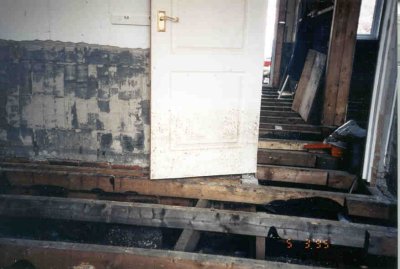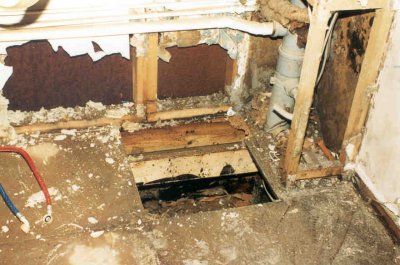

home > what to do > drying out
Do not occupy a house that still contains standing water.
Standing water should be removed with pumps or pails, followed by a wet/dry vacuum to mop up any remaining water.
Your local fire brigade may assist with pumping out of properties, once floodwaters are beginning to subside. It is important not to leave basements full of water if pumping out is possible. Charges may be made for this service.
If you cannot get your building pumped out by the fire brigade, you may be able to hire a pump from your local hire shop (look in Yellow Pages or on the Yell.com Web site), or you can purchase one from a DIY shop . When you hire or buy a pump, ask for advice on the best rate of de-watering - be careful not to de-water too quickly since the pressure of water surrounding the building could damage the foundations of your property. As general advice it is best to drain in stages - about a third of the volume daily.
Do not heat your home to more than 4 ºC (about 40ºF) until all the water is removed.
 Exposing
the under floor area and wall frames to allow drying and examination (photo
courtesy of WA Fairhurst & Partners, Dundee)
Exposing
the under floor area and wall frames to allow drying and examination (photo
courtesy of WA Fairhurst & Partners, Dundee)
Once you have pumped out all the standing water you can begin to dry your property out.
 |
Ideally buildings should be dried out by the central heating system where possible, with the thermostat at 22°C or above. If possible use industrial heaters, fans and dehumidifiers to aid the process. For more information see pages on floorings and walls.
Good ventilation of the building will aid the drying out process, open as many doors and windows as possible. On dry days keep all doors and windows open. On wet days leave windows ajar - the inside of your house can only dry if moisture can get out. If you can, use fans to help to circulate air and to draw humid air out of the building. Fans are more beneficial than heaters - they speed up the drying process by increasing airflow and the evaporation rate within your house.
It is possible to determine whether a building has dried out or not by using a meter, which can be obtained either via building specialists or via a hire shop. A lack of condensation may also indicate that a building has dried out. The length of time that a building takes to dry out is extremely variable and will be affected by a number of factors, including the severity of the flood and the type and thickness of the building materials that have been in contact with the flood waters. You should be prepared for the process to take months rather than weeks in the case of acute flooding.
Chimneys should be dried out carefully, starting with only small fires before
moving on to larger ones, in order to avoid expansion of water to steam (and
therefore damage) within the structure.
 Treating
and drying the area of a building below floor level
Treating
and drying the area of a building below floor level
 Remove
kitchen units to help speed up drying (photo courtesy of WA Fairhurst &
Partners, Dundee)
Remove
kitchen units to help speed up drying (photo courtesy of WA Fairhurst &
Partners, Dundee)
20 November 2002